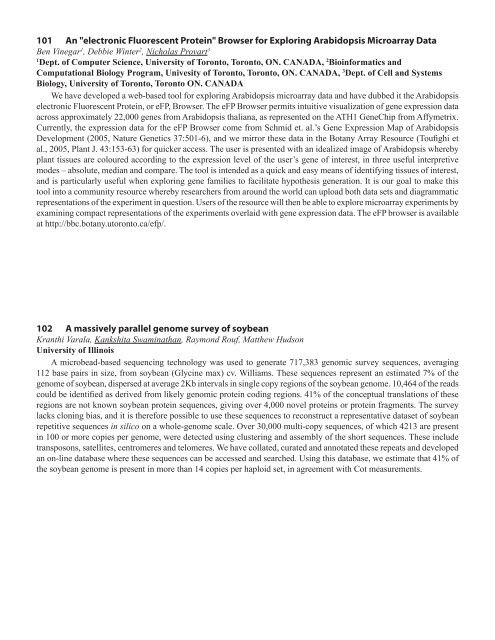75 Integrating Membrane Transport with Male Gametophyte ... - TAIR
75 Integrating Membrane Transport with Male Gametophyte ... - TAIR
75 Integrating Membrane Transport with Male Gametophyte ... - TAIR
Create successful ePaper yourself
Turn your PDF publications into a flip-book with our unique Google optimized e-Paper software.
101 An "electronic Fluorescent Protein" Browser for Exploring Arabidopsis Microarray Data<br />
Ben Vinegar 1 , Debbie Winter 2 , Nicholas Provart 3<br />
1<br />
Dept. of Computer Science, University of Toronto, Toronto, ON. CANADA, 2 Bioinformatics and<br />
Computational Biology Program, Univesity of Toronto, Toronto, ON. CANADA, 3 Dept. of Cell and Systems<br />
Biology, University of Toronto, Toronto ON. CANADA<br />
We have developed a web-based tool for exploring Arabidopsis microarray data and have dubbed it the Arabidopsis<br />
electronic Fluorescent Protein, or eFP, Browser. The eFP Browser permits intuitive visualization of gene expression data<br />
across approximately 22,000 genes from Arabidopsis thaliana, as represented on the ATH1 GeneChip from Affymetrix.<br />
Currently, the expression data for the eFP Browser come from Schmid et. al.’s Gene Expression Map of Arabidopsis<br />
Development (2005, Nature Genetics 37:501-6), and we mirror these data in the Botany Array Resource (Toufighi et<br />
al., 2005, Plant J. 43:153-63) for quicker access. The user is presented <strong>with</strong> an idealized image of Arabidopsis whereby<br />
plant tissues are coloured according to the expression level of the user’s gene of interest, in three useful interpretive<br />
modes – absolute, median and compare. The tool is intended as a quick and easy means of identifying tissues of interest,<br />
and is particularly useful when exploring gene families to facilitate hypothesis generation. It is our goal to make this<br />
tool into a community resource whereby researchers from around the world can upload both data sets and diagrammatic<br />
representations of the experiment in question. Users of the resource will then be able to explore microarray experiments by<br />
examining compact representations of the experiments overlaid <strong>with</strong> gene expression data. The eFP browser is available<br />
at http://bbc.botany.utoronto.ca/efp/.<br />
102 A massively parallel genome survey of soybean<br />
Kranthi Varala, Kankshita Swaminathan, Raymond Rouf, Matthew Hudson<br />
University of Illinois<br />
A microbead-based sequencing technology was used to generate 717,383 genomic survey sequences, averaging<br />
112 base pairs in size, from soybean (Glycine max) cv. Williams. These sequences represent an estimated 7% of the<br />
genome of soybean, dispersed at average 2Kb intervals in single copy regions of the soybean genome. 10,464 of the reads<br />
could be identified as derived from likely genomic protein coding regions. 41% of the conceptual translations of these<br />
regions are not known soybean protein sequences, giving over 4,000 novel proteins or protein fragments. The survey<br />
lacks cloning bias, and it is therefore possible to use these sequences to reconstruct a representative dataset of soybean<br />
repetitive sequences in silico on a whole-genome scale. Over 30,000 multi-copy sequences, of which 4213 are present<br />
in 100 or more copies per genome, were detected using clustering and assembly of the short sequences. These include<br />
transposons, satellites, centromeres and telomeres. We have collated, curated and annotated these repeats and developed<br />
an on-line database where these sequences can be accessed and searched. Using this database, we estimate that 41% of<br />
the soybean genome is present in more than 14 copies per haploid set, in agreement <strong>with</strong> Cot measurements.





